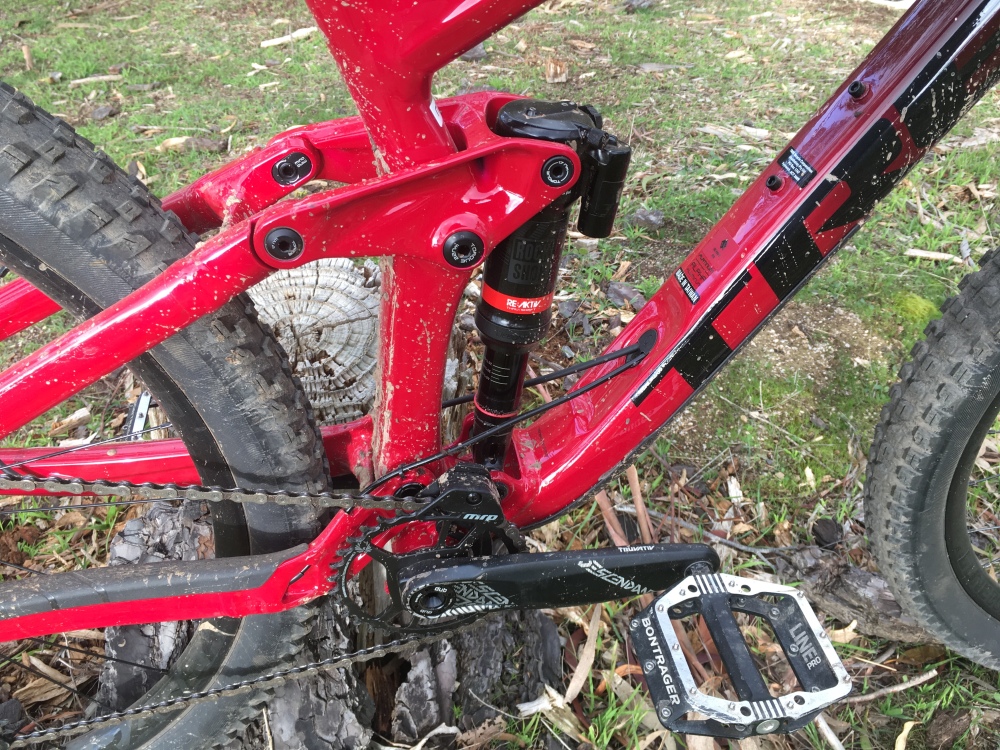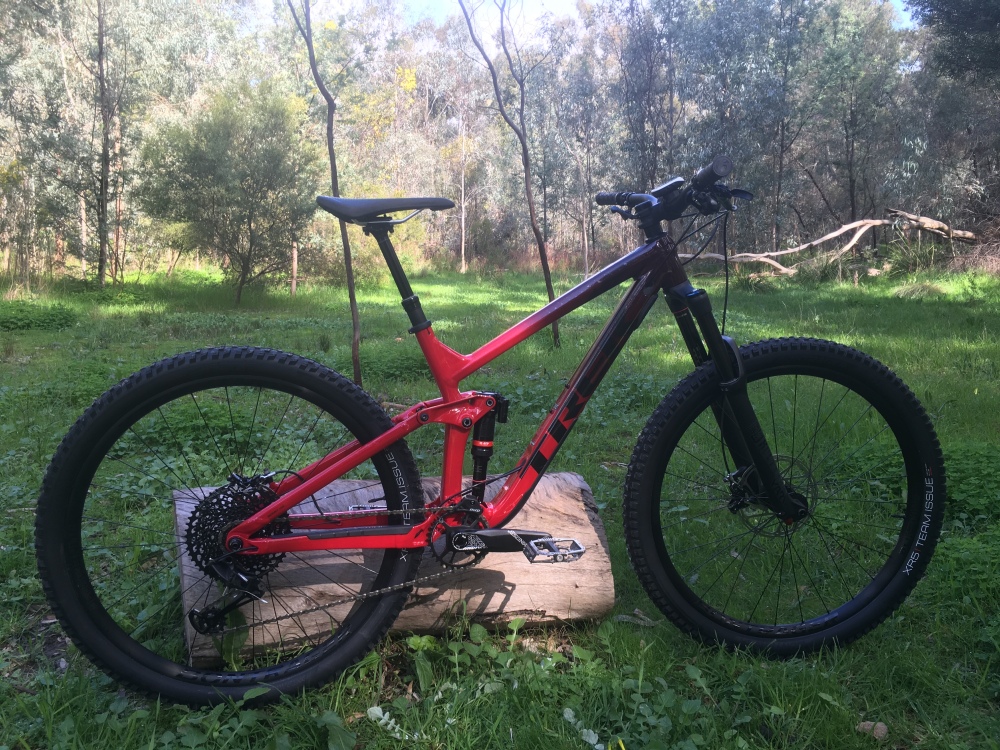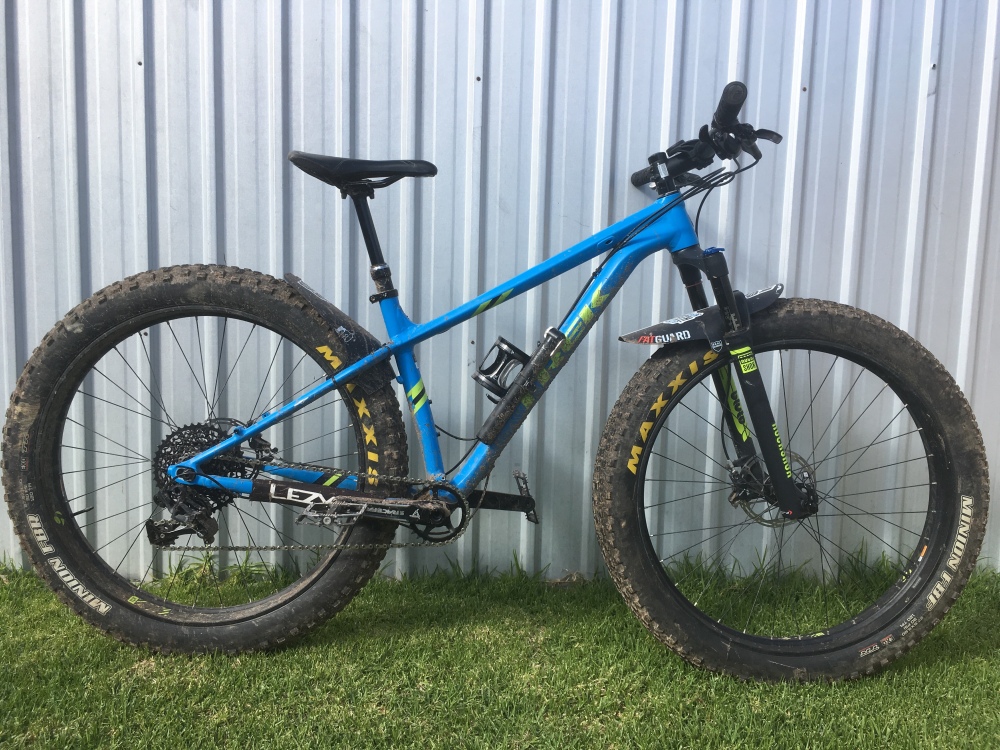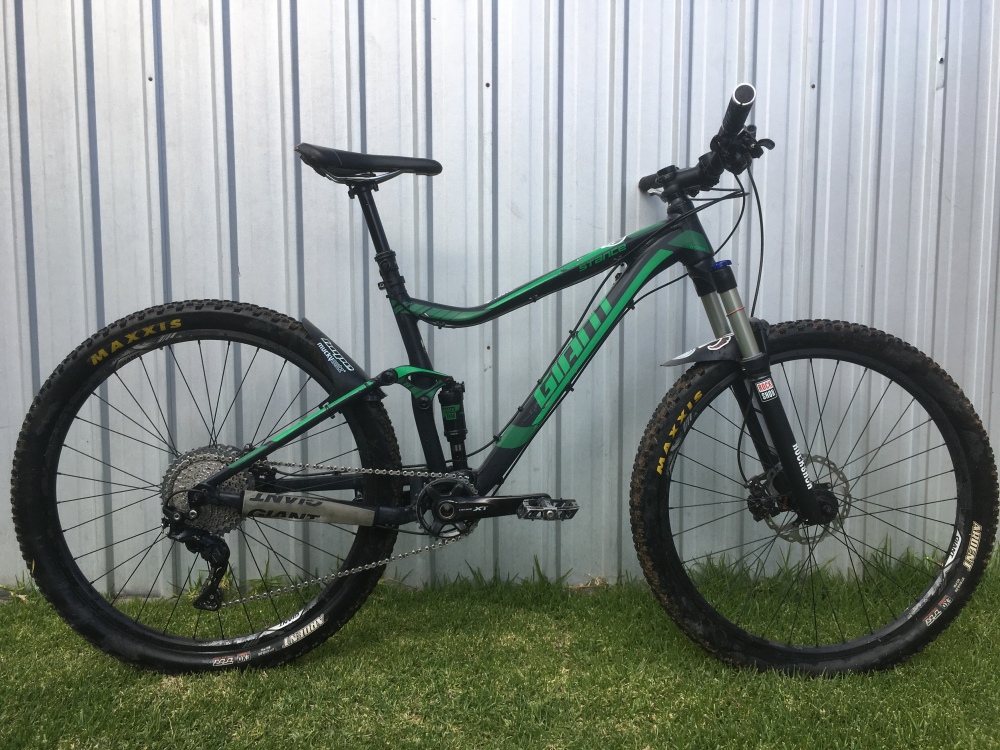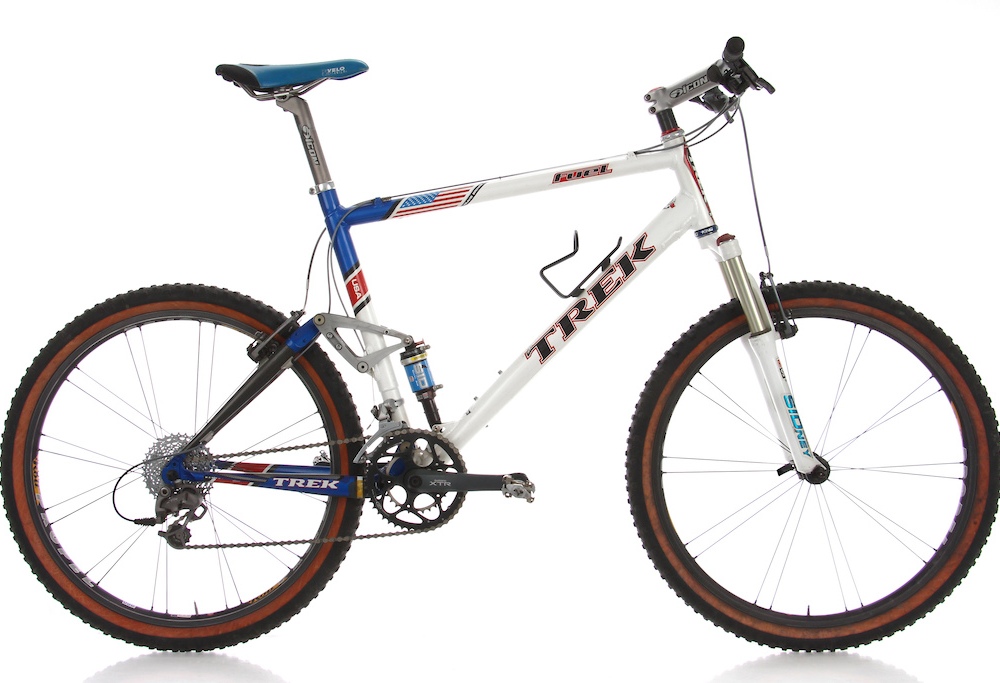If there is a mountain bike chassis that I have been following religiously (other than the Giant Stance), it has been the Trek Fuel. I absolutely adore the Trek Fuel EX for what it does, and how a single frame can spec out the beginner dual suspension market all the way up to an elite fun machine. Aside from Giant, Scott and Specialized; you will be hard pressed to find a versatile trail bike that is available in multiple specs and can perform to the desired price point. The only reason I have not bought a Fuel EX is because I have an emotional attachment to Titan since it got me into both mountain biking proper and was kind of the first mountain bike I reviewed. But if 2015 me had known how far I would go with mountain biking and that the $200 price difference between the 2015 Giant Stance 27.5 2 and the 2015 Trek Fuel EX 5 would be nothing after the upgrades and maintenance I had to put into the Stance, then Titan would have looked like this:

After the release of the Trek Top Fuel range for 2020 and the impending release of the new Fuel EX, I wanted to look back on how Trek made possibly their greatest all rounder and what steps were taken along the way to get where we are now. So how did we get the Fuel EX?
For this article, we are strictly focusing on the “Fuel” line and not the Superfly that sits in the “cross country” bracket, or the Remedy that sits in the “long travel trail” bracket. Sub-divisions such as Top Fuel and Fuel EX are on the table. The top of the range model will be the focus since it demonstrates the greatest innovations for the time and also shows the evolution of “top spec” parts for the time.
Where Do We Start?
According to the Trek official archives, models only begin at 2002 with the Gary Fisher models and 2003 was when we saw the first commercially available “Fuel” model. But there are some reports and evidence to suggest that the Fuel was born on the turn of the century for the 2000 Summer Olympics in none other than Sydney Australia!
https://www.pinkbike.com/news/2000-trek-fuel-vintage-bike.html
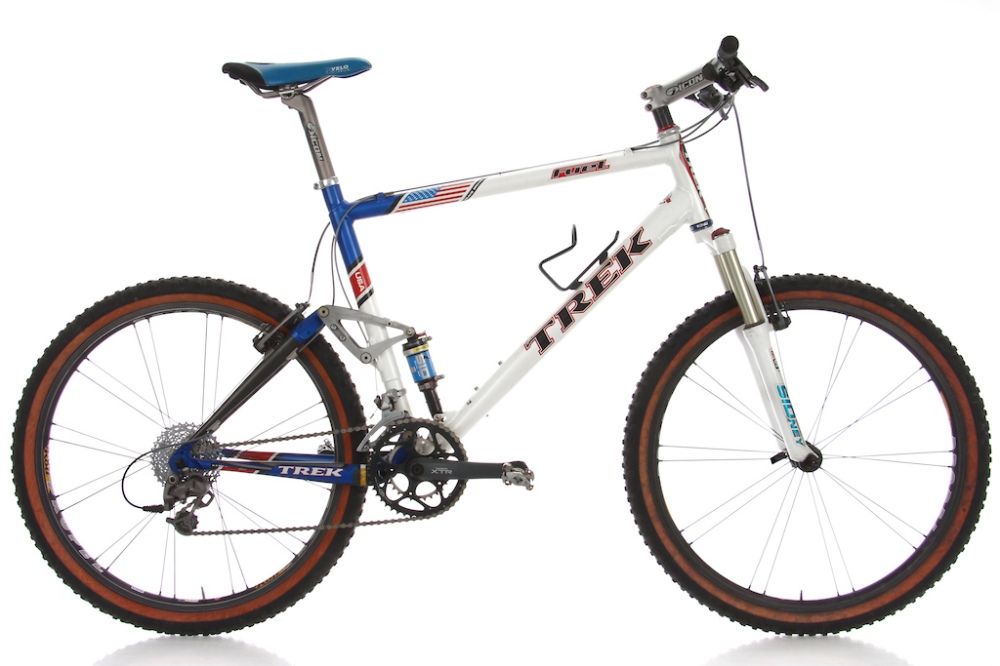
2000 Trek Fuel race bike for Travis Brown. Especially made to take on the 2000 Summer Olympics in Sydney, Australia.
While we may scoff at the rim pull brakes and 2x front chain rings, this was cutting edge for dual suspension bikes, let alone a cross country race bike for the Olympics! Hard tails were the go back then, so it was a bold move bringing a dual suspension rig for America’s Travis Brown to ride. 9 speed cassettes were only now being developed, and this XTR set was cutting edge. Some of my favourite pick ups are the Rockshox SID fork which was labelled “SIDney” for the Olympic Games, and how the geometry is “close” to the modern Top Fuel. We have a single pivot linkage driven suspension which would eventually evolve into the Active Braking Pivot and Float Suspension systems.
In 2003, according to the Trek archieves, the world received the Trek Fuel for commercial sale and it was pretty close to the Travis Brown Olympic Fuel.

2003 Trek 100
This is the top of the range 100 model, and for that title you get OCLV carbon fibre which has become a standard within Trek’s manufacturing of lightweight but strong carbon race bikes. The 100 had the XTR groupset from the 2000 race model, but the triple chain ring was here since Travis Brown “didn’t need a granny gear to race” and by having a triple chain ring back then afforded you the greatest range in gear ratios. There was a “Fuel 90 Disc” model which came with hydraulic disc brakes, but specifications were minimal and no pictures were found in the archives.
2004’s Trek Fuel 100 pushed on with carbon cockpit components and rims from Bontrager, and included Bontrager’s Race Lite Tyres.
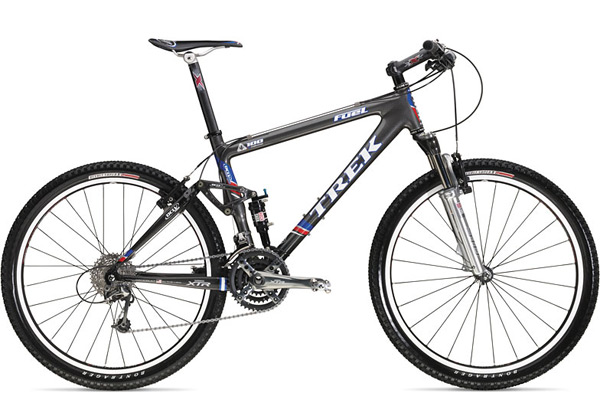
2004 Trek Fuel 100
Geometry and suspension design is preserved from the previous years, but there was a focus on making this year’s model lighter and faster.
Fuel Divisions
In 2005, Trek brought us the next iteration of the Fuel line with the top model being the Fuel 80:
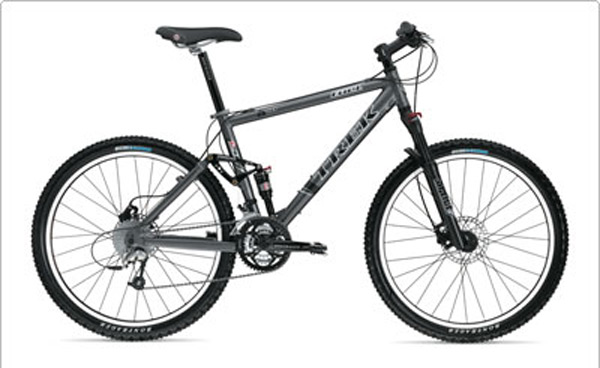
2005 Trek Fuel 80
The 80 now came with hydrualic disc brakes standard, but the frame was aluminium, and the group-set was reduced to Deore spec. This may seem like a backwards step in isolation, but that year Trek also presented the 2005 Trek Fuel EX and the 2005 Trek Top Fuel range!
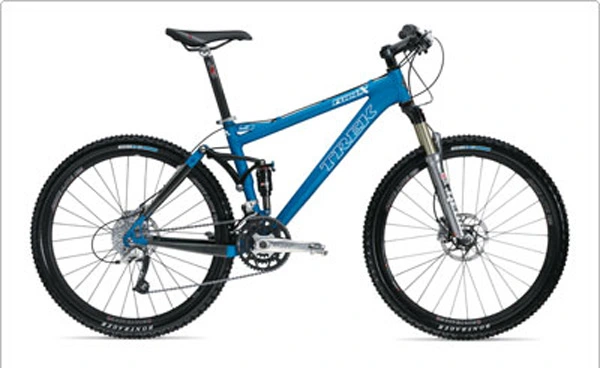
2005 Trek Fuel EX 9. This is the longer travel, heavy hitter when compared to the Fuel 80.
With a beefier frame made of carbon fibre to take heavier hits and be more rigid while shredding trails, increased travel front and rear, the introduction of the Full Floater suspension linkage, and hydraulic disc brakes made the first Fuel EX chassis a revolution in dual suspension mountain bike design and would pave the way for the line to become a commercial success.
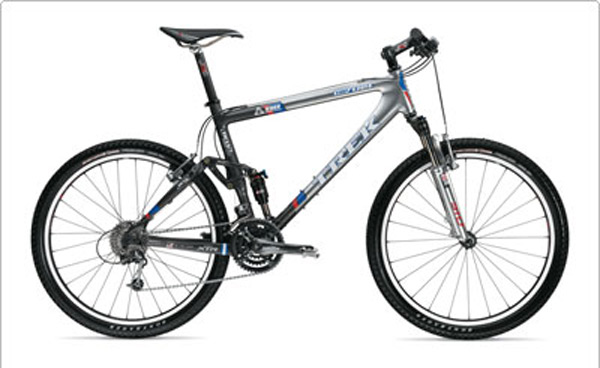
2005 Trek Top Fuel 110
On the other hand, Trek also introduced the Top Fuel and the top of the range was the Top Fuel 110. While it looks understated when compared to the Fuel EX 9, the Top Fuel 110 possessed the shorter travel suspension but had the XTR components, lightweight OCLV carbon frame, and low profile tyres to take on cross country racing. This is only the beginning for the Top Fuel…
2006 gave us another Fuel 80 which had very few things changed from its 2005 ancestor, the 2006 Fuel EX line had another success with the Fuel EX 9.5, and the Top Fuel gained hydraulic disc brakes:

2006 Trek Fuel EX 9.5
The top tube and down tube were slimmed but still retained the rigidity and strength of the previous year’s model, and Trek started speccing SRAM components across the range. While this wasn’t as major of a step as what the 2005 Fuel EX was from the 2004 Fuel, small innovations count. 2006 would also be the final year for the Trek Fuel line up, with 2007 being Fuel EX dominance.

2006 Trek Top Fuel 110
The Top Fuel 110 when compared to the EX 9.5 had advantages in the Shimano XTR groupset, hydraulic Shimano XTR brakes, and the lightweight Bontrager Super X 26×2.1 inch tyres.
2007 gave us another step closer to the modern Fuel EX with the travel boosted from 100mm to 120mm front and rear!
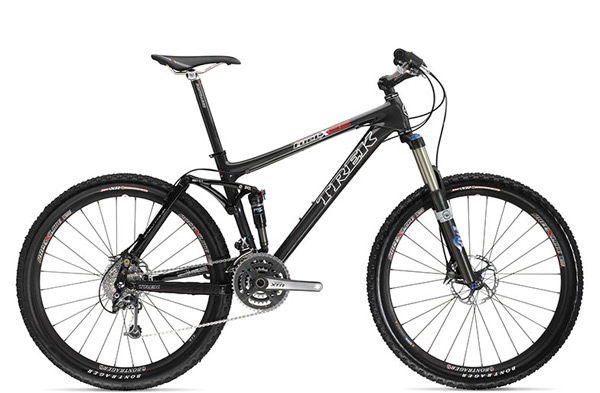
2007 Trek Fuel EX 9.5
The head tube and seat tube were slightly slacker, the chainstays were brought in, Fox suspension came on the top spec models, and we have the first attempt at the Active Braking Pivot design! On first glance you miss most of the details since the 9.5 here and before have identical paint schemes, but rest assured Trek did innovate more on this design and began pushing the Fuel EX to become more rugged and capable of descending and climbing.

2007 Trek Top Fuel 9.9
The 2007 Top Fuels finally ditched the 80-110 scale previously used and blended in with the other lines with the top model being called the 9.9 and the range starting at 7. Like the Fuel EX, the Top Fuel became closer to the modern incarnation by having 90mm of front and rear travel (rather than 80mm), a steeper head tube angle for gruelling climbs, and a lower slung cockpit thanks to stem and handlebar combinations. The Top Fuel was starting to become more specialised than its Fuel EX cousin.
In 2008 the world was still suffering from the finanical crisis but Trek produced more brilliant bikes that transformed the world of mountain biking in both the trail bike and cross country categories.

2008 Trek Fuel EX 9.5
While there doesn’t seem to be much going on, this model was the first to introduce the official ABP or Active Braking Pivot design that we know today, a magnesium EVO rocker link, and the official Full Floater system. Yet we still have 26×2.25 inch tyres on this Fuel EX? The 2008 Trek Fuel EX 9.5 was pretty darn good and honestly I would feel comfortable using this bike today in Bendigo since the increased rotor sizes and slackened geometry does make it worthy of trail bike status. But this is no where near the end!
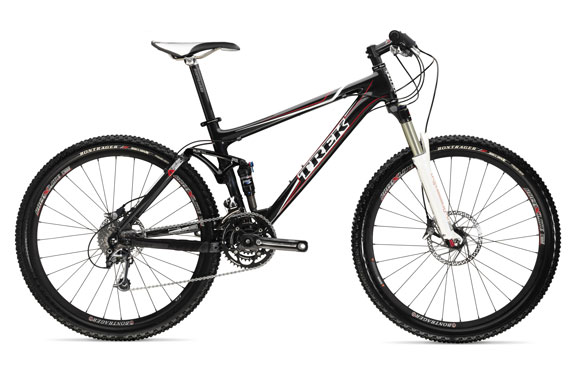
2008 Trek Top Fuel 9.9 SSL
In the Top Fuel camp, the 9.9 SSL had a few tweaks applied. It had a pivotless chainstay and the Shimano XTR systems were updated, but it retained 90mm of travel front and rear and most other frame geometry. Most of the innovation went into frame stiffness and weight reduction. Again, this Top Fuel would do pretty well in Bendigo considering it is 11 years old.
2009 was a straight forward year for the Fuel EX.

2009 Trek Fuel EX 9.9
Nothing really changed. The 120mm of travel remained, Full Floater and ABP was setting the trail riding world on fire, and the only significant tweaks were to the rims making them lighter and stiffer. It’s what happened to the Top Fuel range that must of had Trek’s attention!

2009 Trek Top Fuel 9.9 SSL
Oh my word did the Top Fuel transform! 90mm travel became 100mm thanks to the revised seat tube/top tube junction, it received the Full Floater, magnesium EVO link, ABP rear swing arm, reduced brake rotor sizes, 2x front chainrings, titanium Shimano brakesets which were exclusive to Trek, and improvements in the propietary Bontrager components to improve cross country racing. This was ground breaking for Trek, let alone the Top Fuel range.
The 2010 Fuels received a significant update due to the rear derailleur hanger becoming replaceable. While we take it for granted in 2019, before replaceable derailleur hangers if you smashed your mech it usually meant a replacement since the force from an impact would damage the derailleur. But not a single piece of metal between the frame and derailleur would save it! Sometimes it’s the small things that push mountain biking forward?

2010 Trek Fuel EX 9.9
The 2010 Fuel EX 9.9 remained a solid bike. A few geometry tweaks to make it slightly slacker and the tube joining the seat and top tube was eliminated thanks to the frame becoming more rigid, but otherwise it remained a 3×9 drive train and the Fox suspension package was great on this top end model.

2010 Trek Top Fuel 9.9 SSL
The 2010 Top Fuel was again a step forward since it gained Shimano’s 2×10 XTR groupset, centrelock hubs for the brake rotors, and the lightest cross country components for the time. This cross country race bike wasn’t messing around!
2011 might have been an ordinary year for some of us, but Trek were making small adjustments to their secret sauce. Nothing ground breaking but small improvements to make mountain biking a more enjoyable experience for Fuel EX and Top Fuel consumers.

2011 Trek Fuel EX 9.9
In the red corner, the reigning trail slaying champion the Fuel EX 9.9 finally received the 2×10 SRAM XX system and the centrelock hubs the Top Fuel 9.9 had the year before. But Trek had rejigged the head tube with the new E2 tapered standard to improve head tube stability and improved turn in feel, and Bontrager gave us the XR3 tyre. The XR range is common place on most, if not all, Trek bikes to this day and 2011 was where it all started. Mind you the bike is still a 26 inch wheel bike. The Fuel EX range had a mostly SRAM presence to it in the higher grades.

2011 Trek Top Fuel 9.9 SSL
In the blue corner is the lightweight champion of the world, the 2011 Trek Top Fuel 9.9 SSL! The Top Fuel range benefited from internal cable routing on the carbon models, and some models received remote lockable suspension front and rear which would help on marathon cross country rides. XTR components adorn this cross country cow, and Bontrager’s own components made this a lightweight and nimble machine.
2012 really didn’t differ from 2011 to tell you the truth.
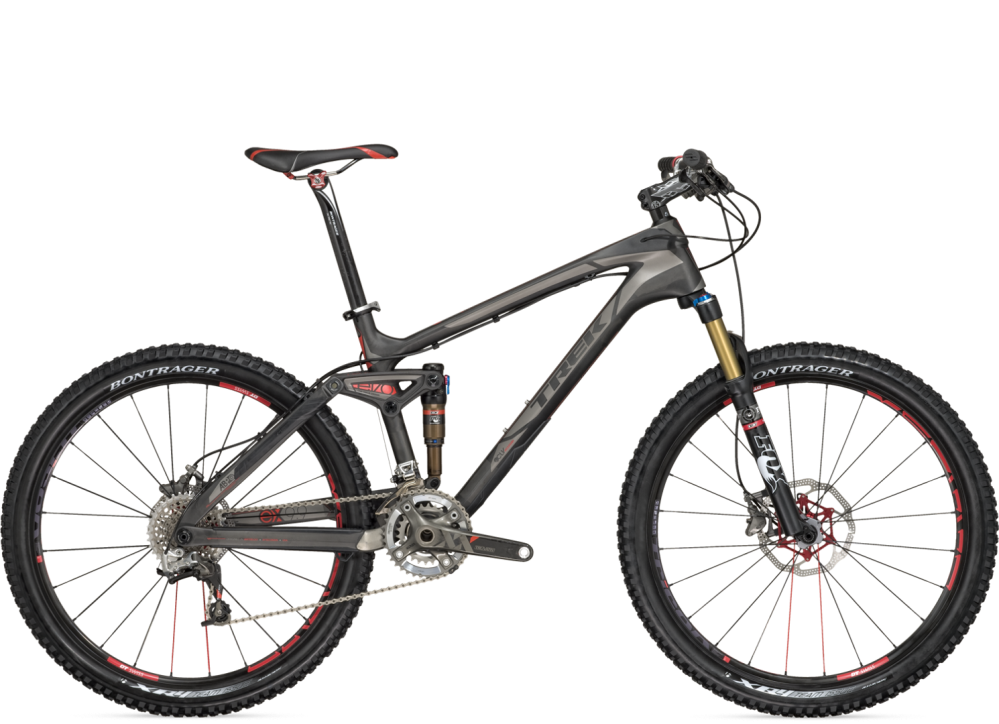
2012 Trek Fuel EX 9.9
With only internal cable routing for the front derailleur and the Bontrager XR4 becoming the tyre spec, there wasn’t any ground breaking revelations other than tidying geometry and producing another solid trail bike?
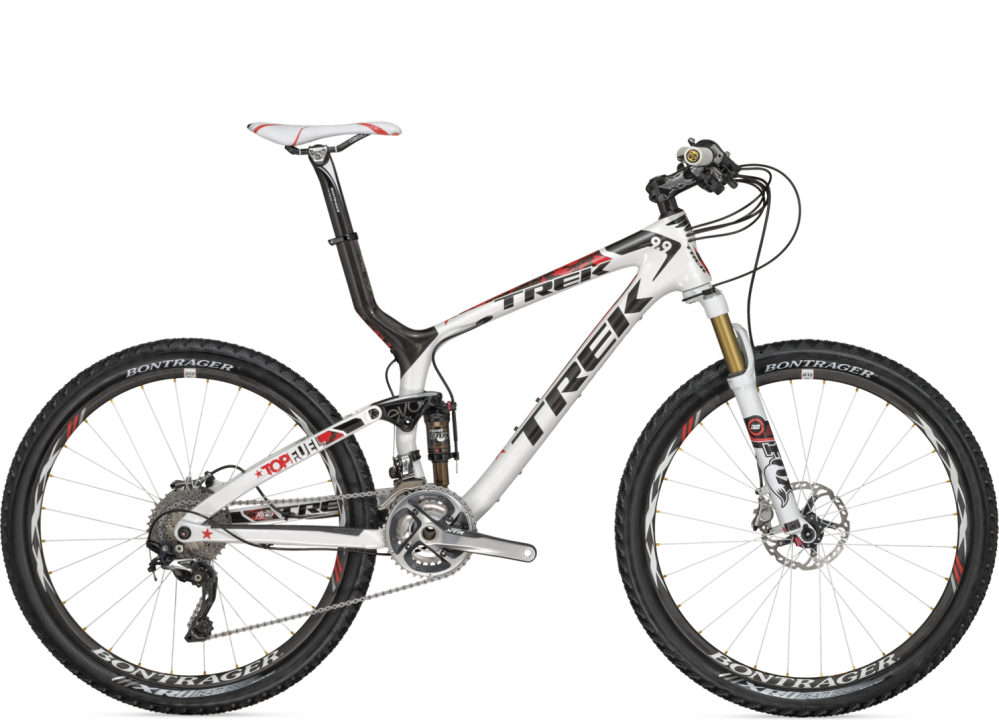
2012 Trek Top Fuel 9.9 SSL
And honestly aside from a minor geometry tweak or two, the Top Fuel just remained as awesome as the 2011 father before it. Still 26er though…
Running One Type of Fuel
2013 was a turning point for Trek for the Fuel line. This was the year we would see the discontinuation of the Top Fuel line so Trek could focus their attention on the Superfly 100. A brief history, the Superfly was their cross country hard tail race bike that soon diverged into a hard tail and dual suspension option. When you have two dual suspension cross country race bikes, you only have so many resources to keep each going and Trek consolidated everything into the Superfly 100 for dual suspension cross country racing. But this meant the Fuel EX took off!
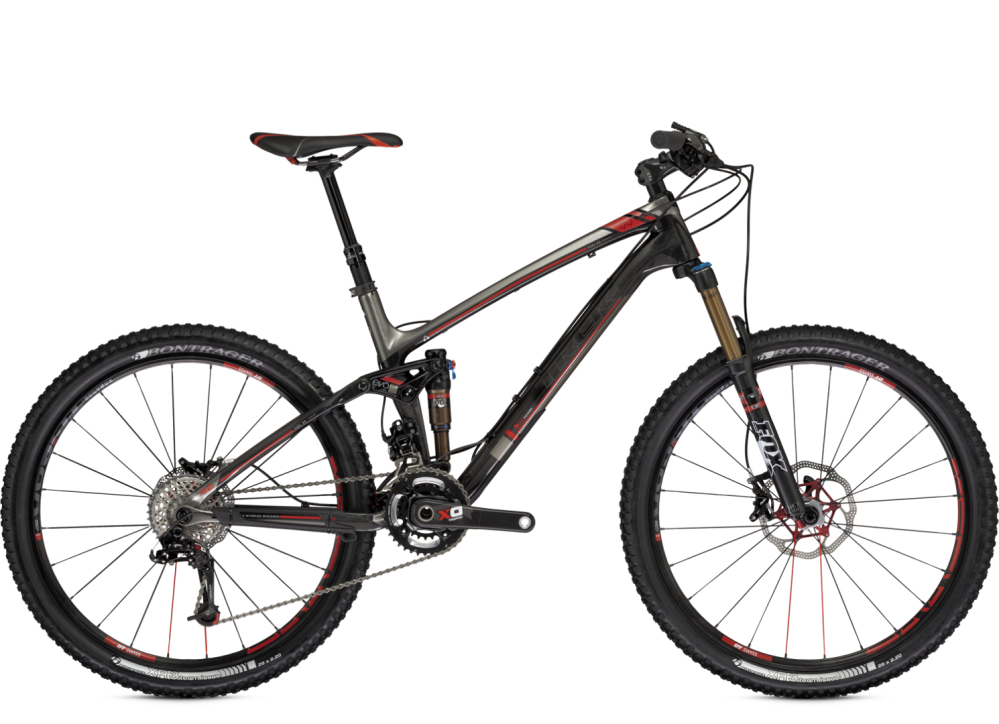
2013 Trek Fuel EX 9.9
With 130mm of travel front and rear, this wonderful thing called a “dropper post”, internal cable routing all around, and improvements to geometry to further cement this line as a dominant trail conquering machine, the 2013 Trek Fuel EX was exceptional and was an indication of where they wanted to take the Fuel EX range in the future.
The 29er Uprising
2014 was another significant year for Trek redesigning the Fuel since a division occurred with the Fuel EX 26 and the Fuel EX 29 lines. This is a bit mental and I need to emphasis how many divisions there were.
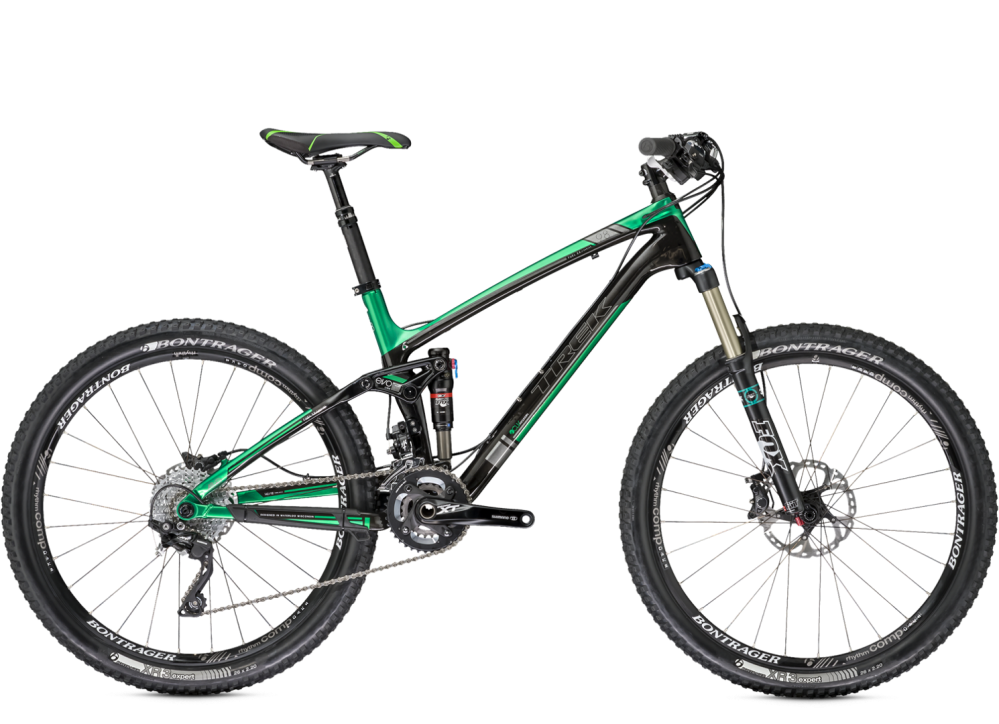
2014 Trek Fuel EX 9.8 26
Keeping with the 130mm travel chassis from the year before, the Fuel EX 26 only came in the highest spec of 9.8. It came with Shimano Deore XT components rather than XTR but it otherwise maintained the improvements that were made for the 2013 Fuel EX. With the Fuel EX 6 26, the EX 8 26, and the above EX 9.8 26; if you were holding out for a 26 inch wheel mid travel trail bike there were some pretty good options. But the 29er Fuel EX range was insane at the time.

2014 Trek Fuel EX 9.9 XTR

2014 Trek Fuel EX 9.9 XX1
The two bikes above use the same 120mm travel carbon chassis which had increased chainstays to accommodate the 29 inch tyre, both had the Rockshox Reverb Stealth, both had the Fox Factory Float shock with ReActiv tuning for the ABP and Full Floater, and the in-house Bontrager components were the same. What was different among the two were the fork and running groupset. The XTR used Fox’s Kashima coated Factory 34 with 120mm of travel, XTR brakes, and the 2×10 XTR drivetrain. The XX1 however embraced SRAM tech by having the Rockshox Revalation RCT3 120mm out front, Avid X0 trail brakes and this new thing called SRAM XX1 1×11. These were both great choices depending on how you wanted your trail bike to perform. A 2×10 system for those wanting an excess of gear ratios and something to pedal up steep hills easily, or embrace the revolution that was 1x. The Fuel EX 29 line up included the 4, 5, 6, 7, 8, two varieties of 9, 9.7, two varieties of 9.8, and the two varieties of 9.9. That was 12 different options on offer and specs had the two options so you could choose SRAM or Shimano components. You rarely get that these days, and maybe Trek was testing the waters to see if people would stick with 2×10 or move onto 1×11, but time would tell.
There Was a 27.5 Fuel EX?
Yep, and it landed in 2015 among the excitement for what 27.5 inch wheels could do. Promises of “faster turn in than big bulky 29ers” but “faster rolling than 26 inch wheels” meant companies like Trek embraced the new wheel size. But this came at the cost of ditching 26 inch wheels from the line up, so if you wanted a 26 inch travel trail bike go back to 2014 now!

2015 Trek Fuel EX 9.9 27.5
This is essentially the best version of what my dual suspension should be. Unfortunately the chassis is 120mm of suspension travel since they hadn’t revised the design to allow larger wheel sizes into a 130mm travel geometry, but the top of the line Fox suspension and Shimano components on board this was a great bike. But there was also an option for Shimano’s Di2 system to be installed to make the 27.5 Fuel EX incredibly desirable. The 29er Fuel EX was also making moves.

2015 Trek Fuel EX 9.9 XTR
Following from SRAM’s market changing XX1 11 speed system, Shimano joined the 1x drive-train market with the XTR 11 speed system. The Fox Factory is a fantastic fork and is well deserving of being on the top model of the Fuel EX 29 series. But what about the SRAM top model?
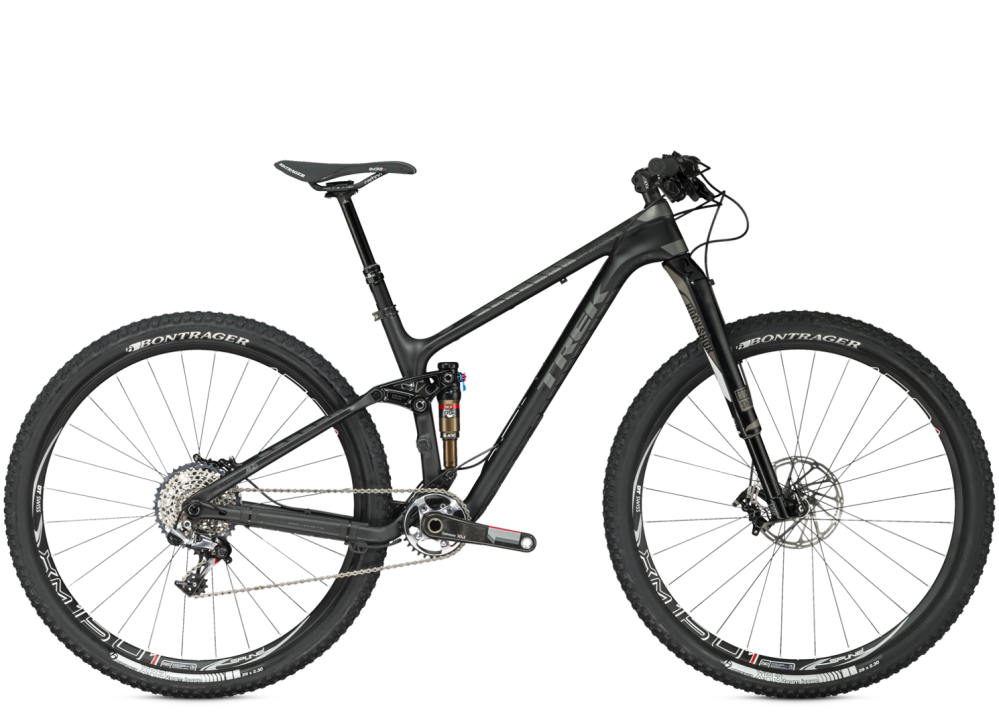
2015 Trek Fuel EX 9.9 XX1
For the 2015 model, Trek adopted SRAM’s RS-1 which was meant to be their premiere cross country fork being inverted and having their leading edge fork technology. The reviews for the RS-1 were not great in retrospect, but this was one of a few bikes at the time that came specced with an RS-1 and seeing as buying an RS-1 to fit to an existing bike was expensive at the time, this wasn’t the worst move. Good on Trek for trying to embrace a new innovation at least.
Bringing the Family Together
Welcome to 2016 where the Top Fuel returned after a three year vacation, the Fuel EX was improved and the range was consolidated, and the Fuel family welcomed a new baby! The Fuel EX is the best place to start.

2016 Trek Fuel EX 9.9 29
The Fuel EX 29 chassis was where Trek made some minor tweaks that were welcome improvements for hard core trail riders. The Control Freak internal cable routing system meant guiding internal cables was easier and they remained more silent on the trail. The Mino Link was introduced to the EVO Link, allowing for the bottom bracket to be raised or lowered, thus the head tube angle would be slackened or steepened so riders could choose to improve climbing or descending stability. Having an option to tweak the performance of your bike for free is a pretty sweet deal. Trek also embraced the new Boost standard for hubs which meant the hubs front and rear got wider, but it also meant wheels were stiffer and cornered with greater precision. Thank you Trek for incorporating Boost hubs! Geometry tweaks as usual to shorten the chainstays and shorten the top tube to keep with “modern” trail geometry trends.

2016 Trek Fuel EX 9.8 27.5
In the 27.5 camp, nothing had really changed. The 9.8 model didn’t receive the Mino Link or Control Freak systems and it kept the 2×10 Shimano Deore system. This was a set up aimed at the casual weekend trail shredder who just wants a granny gear to pedal up a long fire road and then go fast down hill on a whip-able bike. I respect that specification philosophy of this bike.
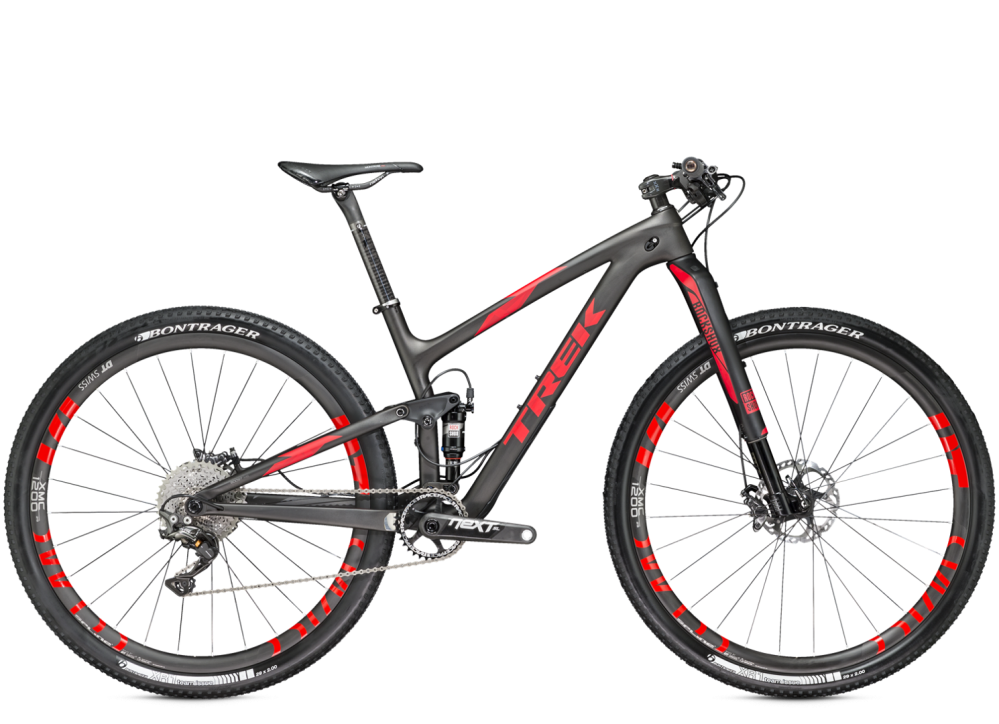
2016 Trek Top Fuel 9.9
The return of the cross country king saw a revised Rockshox RS-1 in the 100mm travel flavour, Control Freak and Mino Link from this year’s Fuel EX (or did the Fuel EX get it from this?), the Shimano XTR 1×11 drive train, and all the upgrades Trek had made to their carbon OCLV process in the 3 year absence. This was a brilliant return to form for the Top Fuel!
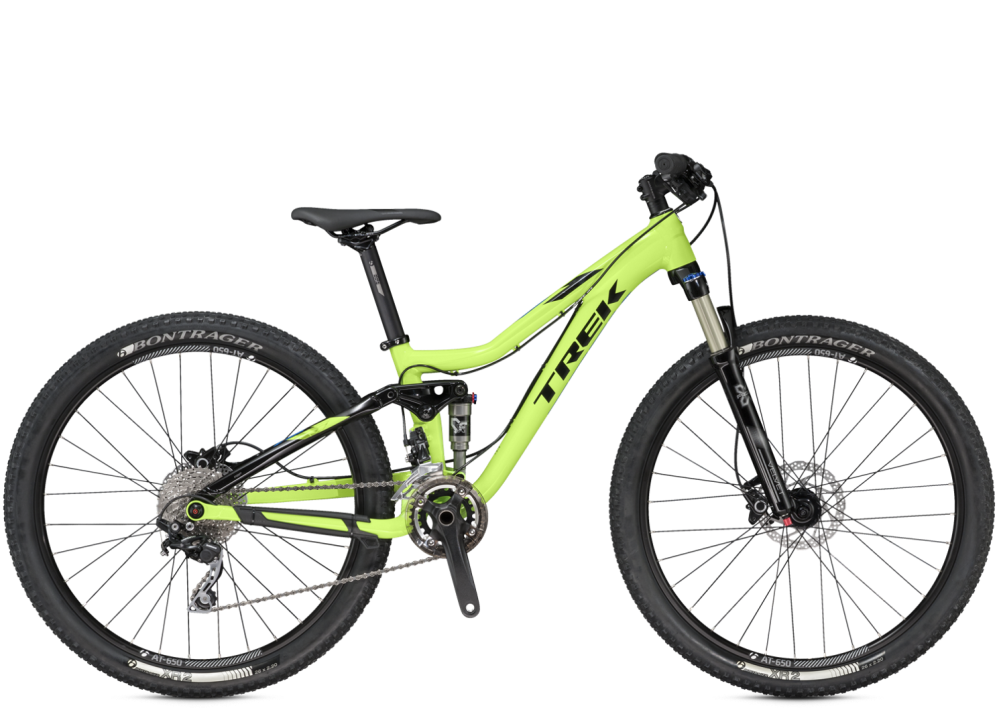
2016 Trek Fuel EX Jr
And the baby of the family was the Fuel EX Jr, a 26 inch minature of the Fuel EX chassis. It had 90mm of suspension travel, adapted versions of the Full Floater and ABP, an EVO link, 2×10 Shimano Deore drive train with bash guard, and an aluminium frame. For kids getting into mountain biking and their parents can afford a dedicated bike for them, this was pretty good.
Precision, Speed, and Grip
2017 is where we see the final developments in the Trek Fuel lines as it stands today.
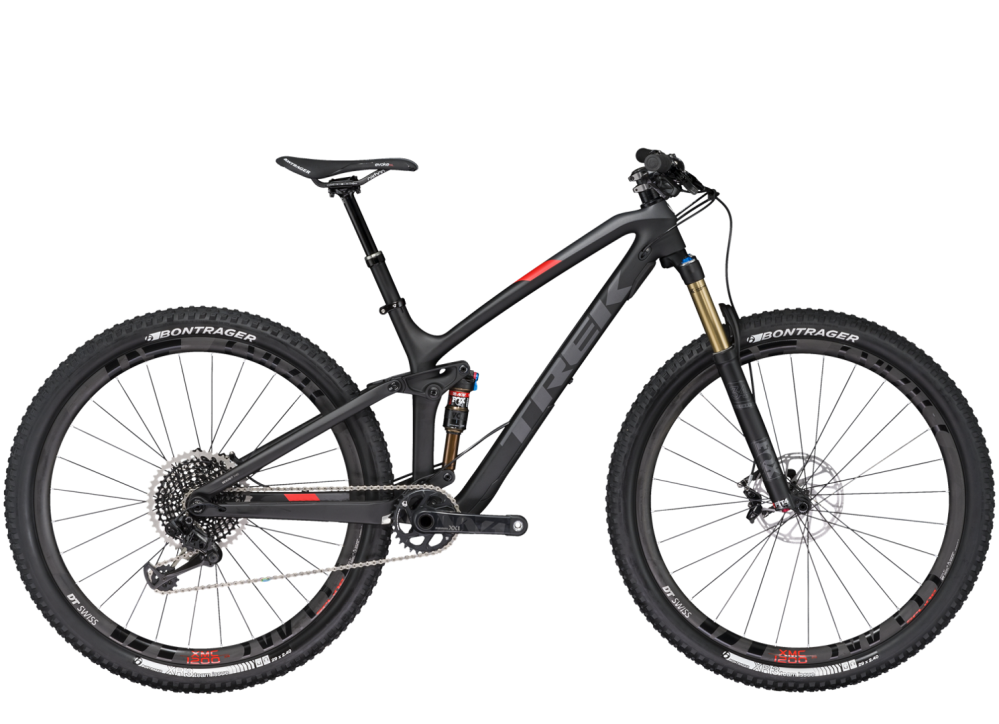
2017 Trek Fuel EX 9.9 29
The 2017 model was all about making a more stiff frame out front for better handling and turn in response, so two key updates were the Knockblock Steerer Stop and the straightened down tube. Between the 2016 model with its swooping down tube and the 2017 having a down tube the directly extends from the steerer tube to the bottom bracket, this made the frame more rigid in the lateral direction and greatly helped in making the front end more planted and controlled. Excellent for tight turns or higher speed downhill turns, as a consequence Trek didn’t want riders crashing and the crown of the fork destroying the straight down tube. The solution was their proprietary head tube spacers called Knockblock which had special rings which would hit each other at certain degrees of rotation to stop the fork and handlebars from over rotating. And this became standard for not only the 9.9 model, but also in more affordable models. Armour was applied to the bottom bracket area of the down tube and up near the steerer tube. This was the first year Trek made it so the frame and chain stays were 1x specific, so no aftermarket fitting a 2x groupset to it. Along with this, Trek embraced SRAM’s new drive train system called Eagle and specced the 9.9 with the top of the line XX1 Eagle. Guide Ultimate brakes for the premium trail brake experience, and Trek included the Bontrager Drop Line Pro which I still maintain is an excellent dropper post on the current market. Shame it only comes in 31.6mm diameter which is what Trek frames run specifically. The 2017 Fuel EX line no longer dabbled in 27.5 wheels, but rather due to increased chain stay clearances, you could opt for 27.5+ tyres. I love this option design choice since in theory, you could have 29 inch wheels for racing and enduro riding while a plus tyre wheel combo could be on stand by for loam riding and more carefree trail riding. And of all things, the Fuel EX was now 130mm of travel! Took 3 years to catch up to where the 26 inch left off.
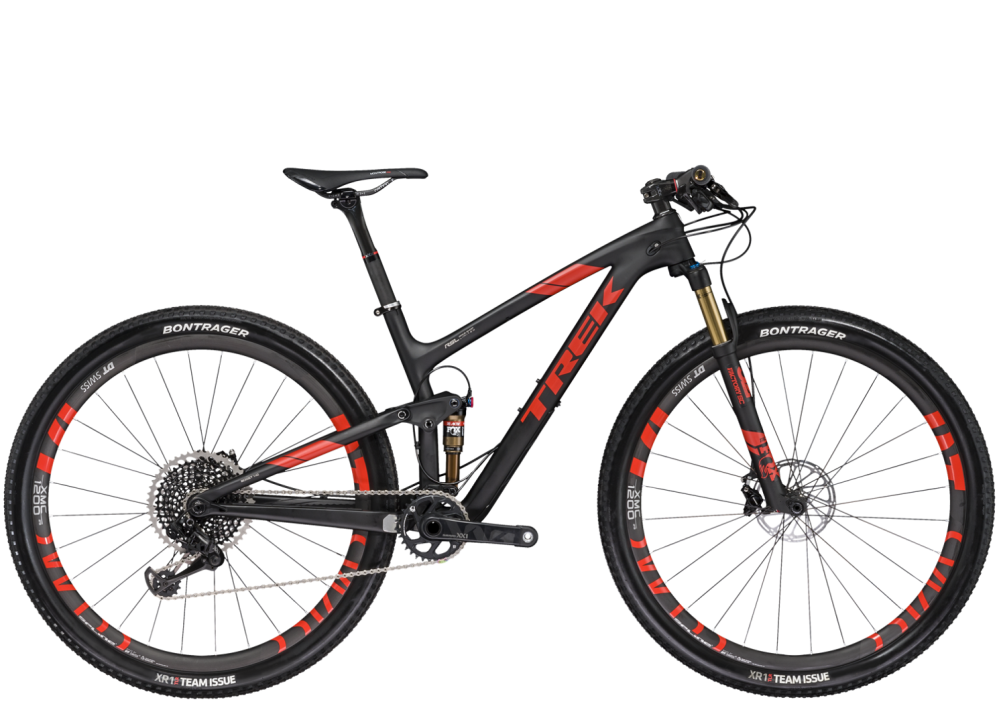
2017 Trek Top Fuel 9.9 Race Shop Limited
Sharing a similar sinister paint job to its trail shredding cousin, the Top Fuel 9.9 Race Shop Limited came with Kashima coated Fox suspension, the SRAM XX1 Eagle, and updated cross country geometry to take on the world. There was no mistaking this for anything other than a cross country race bike.

2017 Farley EX 9.8
There are people in this world that appreciate the finer things, like Dakar rally trucks or Trophy trucks rather than drooling over Monster Jam monster trucks. Real suspension, big tyres, a lightweight but strong frame, and parts that were made to be pounded by a boulder. Welcome to the Farley EX! I know I said I wasn’t going to cover anything outside of the Fuel range, but in essence this is the unholy marriage of the Farley (such as Warpath) and the Fuel EX. This is a dual suspension trail fat bike and everything is spot on. Compromises between the Farley’s hard tail geometry have been brought over to the Fuel EX rear suspension linkage to provide 120mm of rear travel. And it has ABP, Full Floater, EVO link, and Control Freak. This is true love for me and it is a shame I have never ridden one…
The Current State of Play and the Future
For all the searching I did, I could not force the Trek website to give me the images or specs for the 2018 range. Reading bike reviews and looking at the specs, not much had honestly changed from 2017 models aside from SRAM Eagle technology trickling down. Here is the 2019 year lines and how they stack up.

2019 Trek Fuel EX 9.9
With 130mm of travel, over 11 years of dual suspension technology (remember ABP and Full Floater emerged in 2008 and it took years to get to that), Knockblock Steerer Stop, and Trek’s OCLV carbon frame which has been a core part of the Fuel line since it’s introduction in 2003; the Fuel EX line represents one of the best trail riding 29ers you can get. With the range adopting 1x systems across the range from both SRAM and Shimano, this is a robust chassis for technical climbing, technical descending, and can be thrown into the air for casual visits away from earth. There isn’t much that can be revealed for 2020, but I expect great things from the new Fuel EX.
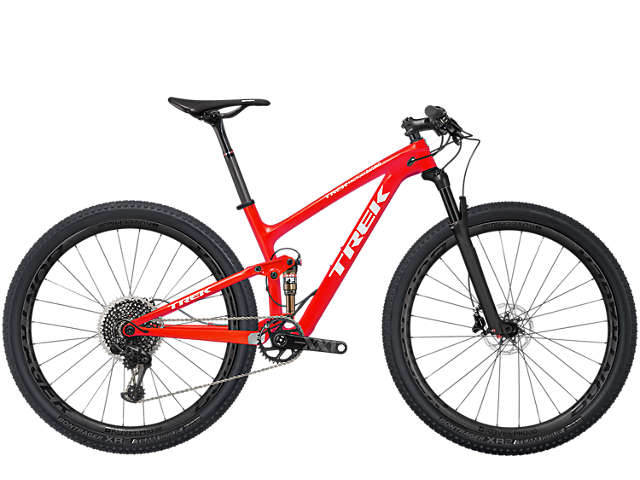
2019 Trek Top Fuel 9.9 SL
The 2019 Top Fuel may be the last time you see 100mm of suspension travel front and rear on a cross country race bike of this name. 10 years before it had been 100mm of travel with a carbon frame, and the 2019 model was one of the best cross country race bikes you could get.

2020 Trek Top Fuel 9.9
The new Top Fuel addresses how cross country courses are becoming steeper and more technical, so it comes with 120mm of suspension travel and dropper posts standard across the range. With an inverted rear shock, it helps to repel dirt from the seals more easily, and the stanchion and internals are submerged in oil for longer which assists with performance over longer cross country marathons. There is also an option for the SRAM AXS equipped super bike for those wanting to embrace wireless technology fully and don’t believe Skynet won’t take over their race bike. I still anticipate a new shorter travel cross country bike, but I believe it won’t be a “Fuel” line up bike.

2019 Trek Full Stache 8
The Farley EX came and went, but the new love child was between a Stache (29+ hard tail) and the Fuel EX line. And it is a great bike (https://throughanamateurseyes.wordpress.com/2018/10/08/rider-files-36-full-on-stache/) and looking back on my review of it, I smile thinking of how much fun it was and how it did possess the familiar Fuel EX DNA. The thing that is still perplexing me is why is it the Full Stache 8? There were no other Full Staches at the time, so did this spell out that Trek were/are going to release a carbon frame version in 2020? For those looking for a dual suspension plus bike, I dare you to try this and not smile.
Then and Now, Trek or the World? What Makes You Innovate?
Look at the 2000 Trek Fuel versus the 2020 Trek Top Fuel 9.9. Aside from the image size difference, there is fundamentally nothing different between the models. While geometry changes, components are improved and the wheels are 3 inches in diameter different; they are both Trek’s dual suspension cross country race bike.
In the world of engineering, nothing is designed by accident and alterations don’t happen over night. You have a design brief and the team must stick to it while also abiding by the manufacturer’s core values and beliefs, and also never transgressing ethical and moral guidelines. And this is what makes the Trek Fuel line so impressive is that in essence, a Trek Fuel was ridden for the 2000 Sydney Olympic Games and the new Top Fuel can be ridden at the 2020 Tokyo Olympic Games.
Just focusing on the frame and the geometry, how do we innovate the Fuel chassis while sticking within the design brief? The Trek Fuel EX is essentially their “do it all trail bike” implying that the bike must climb well and descend with confidence. If we became engineers at Trek, does that mean we could realistically make the head angle slacker and lower the bottom bracket? Yes and no. We could propose that we slacken the head tube angle by 0.5 degrees, but that doesn’t mean the final production bike will be built this way. For that, a prototype would be built that tests our theory and it would be tested on a particular course by test riders. And our prototype would also be tested against another theory that “longer chain-stays give the front end more grip” and “stepper seat tube for more even weight distribution”. And this is what Trek and many other companies do, is that they will tweak geometry for test bikes and then actually ride them. When they have test ridden a bike with amended geometry and compare it to the other changes for the bike, the designers/engineers then have to consider whether it links back to the design brief and philosophy of the mountain bike line; and how it fits into the holistic view of the company’s products. So we could make a longer and slacker Fuel EX, but does it “handle like an all round trail bike should”, does it “realistically improve on the previous design and therefore is worth changing manufacturing”, and of course “is the redesign more in line with what the Remedy and Slash currently do”? If it stays within the design brief, the cost of altering manufacturing needs to change is outweighed by having a significantly improved bike, and doesn’t clash with another design, then we implement our new design and sell it!
When Trek/Bontrager develop proprietary technology that goes into their products, it is another area to consider how developing, testing, and manufacturing give us the final bike product lines we see each year. The Mino Link is an excellent example, because it wouldn’t have happened overnight and it might have taken years of prototypes to get right. The Mino Link has a simple, yet radical function of lowering the bottom bracket and slackening the head angle, or inversely raising the bottom bracket and making the head angle steeper. While this obviously effects climbing and descending capabilities, we need to consider the stresses it places on the bike and how the Mino Link itself was designed. The Mino Link is a small piece of metal recessed within the EVO Link and how it interfaces with the seat stay of the rear suspension linkage. That means there is a new sheer point for heavy impacts to break, it could induce another fulcrum which in turn can make the rear end too bendy, and if the Mino Link is not within a certain tolerance of manufacturing when it is fit to the frame then it could rattle about within the recess and make the rear end unstable. Trek would have done hundreds to thousands of tests on the trail, and their quality assurance division would ensure the last point never happens. But this is what goes into making a small but ground breaking development, not just an idea that is built but the details that go into design, testing, and manufacturing. The Mino Link is a certain length and this influences how the geometry raises and lowers when flipped. In testing there would have been shorter versions but the difference between flipping would have been negligible. Longer Mino Links would have exaggerated the bottom bracket height and head angle, but it might have made the bike too unstable in some ways or put the rider in harm thanks to the bottom bracket striking the ground. Trek and Bontrager innovate, but once you realise how the design process happens, you can appreciate that nothing happens with a snap of the fingers but rather a dedicated team working tirelessly to make the best bike in the world.
The question then remains, what about innovations with components and wheel sizes? We have seen Fuels with 26 inch wheels and 3×9 drivetrains, and the most recent Fuels with 1×12 and 29 inch wheels. Shimano, SRAM and Fox have all taken to the centre stage with the Fuel 9.9 models, so what goes into manufacturers influencing Trek and the final models?
The first radical standard change that comes to mind and how it altered Trek’s production was Boost Hubs. Context on what “old school hubs” were was that bikes were either 26 inch rims or 700C and the hubs were built so that the wheel was stable under lateral cornering forces. The hub, spokes and the rims make a triangle and the shorter and fatter a triangle is, the more it can resist deforming when pushed sideways. So old school hubs worked well because 26 inch wheels were fairly standard until 2014 when Trek rolled out the 29er Fuel EX range. And at the time, other brands like Giant and Scott were also still using old school hubs and building 29 inch wheel bikes for cross country and trail riding because 29ers have fantastic properties of rolling over small imperfections and roots more easily. 2016 was when Trek adopted the new “Boost” standard to their frames which saw bottom bracket get wider for the front and rear. This Boost Hub would also be adopted by the other brands but Trek went for it in both their 27.5 and 29 models, and it allowed the wheels to flex less under heavy cornering and improved the trail riding characteristic of the bike. Seeing as this was an innovation that improved the bike and fit within the design brief for both Fuel EX and Top Fuel, it was adopted across the board for both affordable aluminium models and higher end carbon models.
The argument of whether 26 is dead and if 27.5 should pack up and go home also applies to the Fuel lines. 26 inch wheels served all Fuel lines for a significant amount of time, over half its current history is thanks to the humble 26 inch wheel. But when 29 inch wheels had more favourable characteristics for cross country and endurance rides, Trek shifted their designs and manufacturing to incorporate a wheel size that benefited the philosophy of what a modern cross country and trail bike should be. 26 inch wheels still have a place in modern mountain biking, thanks to their smaller rotating mass and decreased side profile they are excellent on slope style bikes and dirt jumpers in comparison to 27.5 and 29 inch wheels. So the argument that 26 is dead only occurs when the public look at the majority of mountain bikes sold, which is going to be cross country, trail, and enduro rather than downhill and slope style. Trek phased out 26 inch wheels not because they hate them, but because the new wheel sizes on offer improved the characteristics of the bike they wanted to sell to you as the consumer. 27.5 is in an odd place at the moment, its either a core wheel size or a plus tyre option among model line ups. Innovations in hub, rim, and suspension design have allowed for 29 inch bikes to have longer travel and handle better but it won’t out rule 27.5. Trek still have the Fuel EX in a 27.5 plus version, but the Fuel EX chassis works well with a 29 inch wheel. Trek will continue to evolve the Fuel EX, Top Fuel and whatever Fuel mountain bikes beyond 2020 but what wheel size they realistically choose is up to how they believe the bike should handle and if the wheel size imbues that handling.
And then of course there is whether component manufacturers influence the design of the bike manufacturing industry and the answer is yes and no. If a new component has the ability to improve a bike and fits within the design brief and model budget, then it will be embraced. For a trail bike it must be durable, reliable, and easy to use. A cross country bike also relies on these things, but also being as light as possible and as many gear ratios to take on varying altitude and challenge under race conditions. That’s why the early Trek Fuels expanded from having 3×9 to 3×10 systems and remained that way until 2×10 drive trains had a wider spread on the rear cassette, rather than jumping straight to 2x systems because “they are lighter and less complex”. That is true, but if a 2×10 system has one less gear at the front but the same spread of gears on the cassette and is just as heavy, 3×10 in theory and practice will reign supreme. The 2014 Fuel 9.9 29 models showed this difference in drive train preference since cross country riders may want a lighter drive train at the expense of less gear ratios with the XX1, but the XTR system had proven itself in previous years and had a wider range of gears. Another consideration is, not might but definitely is, that some consumers like having a multi-ring drive train since they can use the lower gear to trundle up hill with less effort but higher cadence and Trek acknowledge that. Trek have however converted all Fuel EX and Top Fuel models to be 1x these days, and they no longer offer a bracket to mount a front derailleur. But Trek decide on their terms when to embrace new innovations in components for the benefit of the consumer. They did embrace the RS-1 for a generation of Fuel EX and a Top Fuel, but they switched back to “regular” forks. Dropper posts have been around for a while and manufacturers had been making them lighter and more streamlined, but the Top Fuel models have only come standard with them as of 2020 and I’m pretty sure if you bought a 2020 Top Fuel and you didn’t want the dropper the store would be more than happy to swap it out. So will cassettes get larger, dropper posts get longer, and wireless technology slowly integrates into our mountain bikes? Who knows but Trek will keep to their design briefs for every bike line and price model, and will bring something to market if it means making a better bike for people to enjoy.
Conclusion
This has been one of the longest, and most researched pieces I have done in a long time, so thank you for making it to the end. It was enlightening seeing how far the Fuel line has progressed over the 20 year history, and when innovations like the ABP, Full Floater, and Knockblock came about. I’ve also enjoyed talking about engineering design, prototype theory, and manufacturing issues since this was something I kind of left behind when I chose to do radiography and not pursue mechanical engineering. What Trek has in store next remains to be seen, but I am confident that this year’s Fuel EX and every bike here and after will be great. Thank you again for reading!


